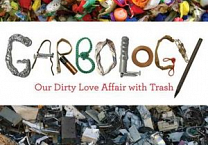Talking Trash… and Doing Something About It
by Charissa Rigano
16 May 2012
Some things are really hard for me to get my head around….the number of people in the world, the number of people who vote for American Idol contestants and the amount of trash that Americans generate.
 Last week, I heard an interview with Journalist Edward Humes about his new book Garbology: Our Dirty Love Affair with Trash. It is no surprise that Americans generate more trash than anyone else on the planet. Each of us throws away more than seven pounds of trash each day. Mr. Humes follows the journey trash takes from garbage containers through landfills, sanitation plants and scrap heaps. Because much of our trash is immediately hidden from our daily lives, it's easy for us to be wasteful.
Last week, I heard an interview with Journalist Edward Humes about his new book Garbology: Our Dirty Love Affair with Trash. It is no surprise that Americans generate more trash than anyone else on the planet. Each of us throws away more than seven pounds of trash each day. Mr. Humes follows the journey trash takes from garbage containers through landfills, sanitation plants and scrap heaps. Because much of our trash is immediately hidden from our daily lives, it's easy for us to be wasteful.
Why should we care?
Here are a few reasons. The amount of trash we generate is changing everything, from the California landscape to marine insect ecosystems.
California is home to the largest active landfill in the United States in Puente Hills. This landfill has been collecting garbage for more than 60 years and has filled a valley that used to be a dairy farm. It is now a 500-foot tall mountain built of 130 tons of garbage. It is the biggest man-made structure in California and you can see the entire basin of Los Angeles from the top. Is that something for the beautiful state of California to boast about?
Not only is our trash changing the landscape, it is also changing the way species interact. The Guardian reported this week that the reproductive habits of marine insects in the Pacific Ocean are evolving in response to environmental changes from the increasing amount of plastic rubbish in the great Pacific garbage patch. Debris from the patch has had an impact on other marine life, including ingestion by fish and invertebrates at a rate of roughly 12,000 to 24,000 metric tons per year. It also transports pollutants and has introduced alien species into new areas.
From what I’ve seen, companies have yet to make the game-changing reductions in their own waste or in the way consumers use their products that are necessary to address the waste crisis in a meaningful way. It is common in CSR reports to see a 10% solid waste reduction goal but rare-to-unheard-of to see a radically different approach to materials and disposal. We need to raise the bar in this area. Reading Garbology is a good place to start.




